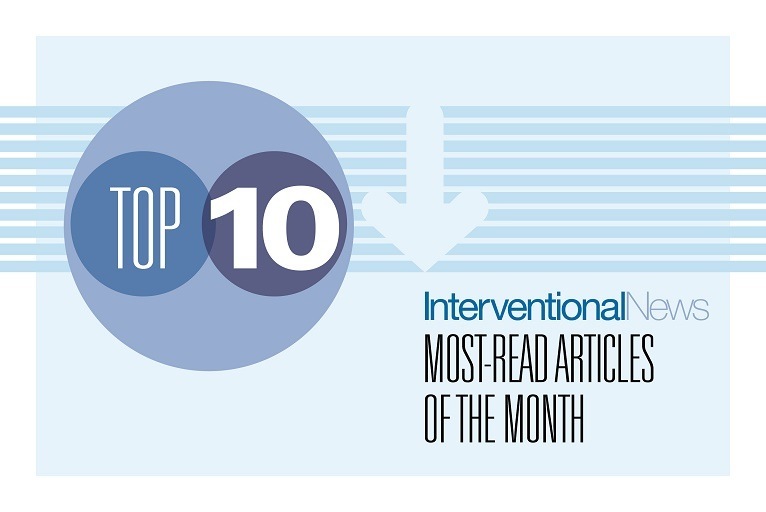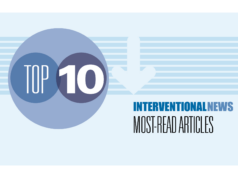 Our top 10 stories of February 2021: a success story for interventional oncology as intra-arterial delivery of chemotherapeutic agents is shown to improve survival, and a new trial investigating combined radioembolization and immunotherapy for hepatocellular carcinoma (HCC) treatment launches; the vascular community gears up for paclitaxel discussions at the 20–21 Charing Cross Symposium (CX; 1922 April, virtual); and various devices cleared by the US Food and Drug Administration (FDA).
Our top 10 stories of February 2021: a success story for interventional oncology as intra-arterial delivery of chemotherapeutic agents is shown to improve survival, and a new trial investigating combined radioembolization and immunotherapy for hepatocellular carcinoma (HCC) treatment launches; the vascular community gears up for paclitaxel discussions at the 20–21 Charing Cross Symposium (CX; 1922 April, virtual); and various devices cleared by the US Food and Drug Administration (FDA).
1. IO solutions for patients with brain tumours: Intra-arterial delivery of chemotherapeutic agents improves survival
The use of intra-arterial delivery for the treatment of malignant brain tumours is safe and provides clinical benefits in terms of survival when used with the appropriate therapeutic agents, according to a small phase II study presented at the virtual European Conference on Interventional Oncology (ECIO; 24 February, online). Delivering these results, Gérald Gahide (Sherbrooke University Hospital, Sherbrooke, Quebec, Canada) told delegates that while the present study demonstrated the technical feasibility and safety of this application, “there is a dire need for designing multicentre, prospective, phase III studies to properly compare intra-arterial and intravenous treatments”.
2. NICE recommends selective internal radiation therapies for the treatment of hepatocellular carcinoma
The National Institute for Health and Care Excellence (NICE) has issued guidance recommending the use of selective internal radiation therapy (SIRT) for the treatment of patients with hepatocellular carcinoma (HCC), the most common form of liver cancer, with more than 6,400 cases diagnosed annually through the National Health Service (NHS) in England, Wales, and Northern Ireland.
3. Introduction of dedicated vascular limb salvage clinic improves one-year amputation outcomes for CLTI patients
One-year outcomes of patients with chronic-limb threatening ischaemia (CLTI) treated in an outpatient-based vascular limb salvage clinic show an improved rate of major amputation. Authors Andrew Nickinson (University of Leicester, Leicester, UK) and colleagues write in an online European Journal of Vascular and Endovascular Surgery (EJVES) article that their study supports the recommendations of the Global Vascular Guidelines and “provides a reproducible service model that delivers timely vascular assessment in an ambulatory setting”.
4. FDA advisory panel recommends against premarket approval of Lutonix 014 DCB for BTK use
An FDA advisory panel has recommended against premarket approval of BD’s Lutonix 014 drug-coated balloon (DCB) for use in below-the-knee (BTK) arteries. In a meeting on 17 February, the majority of the FDA Cardiovascular Devices Panel concluded that the device was likely safe in BTK arteries, but not effective. The benefit-risk ratio also did not appear favourable for the Lutonix 014 DCB, it claimed.
5. CX to host “vital” global discussion of paclitaxel controversy
Andrew Holden (Auckland City Hospital; University of Auckland, Auckland, New Zealand) speaks to Interventional News ahead of this year’s Charing Cross Symposium (CX), which is being held online 19–22 April. In 2021, the conference will focus on controversies within the vascular and endovascular space.
6. Terumo reaches agreement to acquire predictive analytics specialist Health Outcomes Sciences
Terumo Corporation has signed a definitive agreement to acquire all assets of Health Outcomes Sciences, a specialist in predictive analytics and clinical decision support for healthcare organisations.
7. HydroMID midline catheter from Access Vascular receives FDA clearance
Access Vascular has announced US Food and Drug Administration (FDA) clearance of its HydroMID midline catheter.
8. New trial investigating combination therapy of radioembolization and immunotherapy in HCC patients launches
The Society of Interventional Oncology (SIO) and Boston Scientific have announced a new multicentre, prospective, randomised trial to study combination therapy of radioembolization and immunotherapy in early and intermediate hepatocellular carcinoma (HCC) patients not eligible for curative treatments: ROWAN.
9. Rist Neurovascular radial artery catheter receives FDA 510(k) clearance
Rist Neurovascular recently announced that it has received FDA 510(k) clearance to market the Rist Cath Radial Access Long Sheath (Rist Cath) for the introduction of interventional devices into the peripheral, coronary, and neurovascular system.
10. “Indisputable evidence” that DCB is the “gold standard” for treating vascular access stenosis
Tobias Steinke (Düsseldorf, Germany), Matteo Tozzi (Varese, Italy) and Robert Shahverdyan (Hamburg, Germany) give their reactions to the publication in the New England Journal of Medicine of the IN.PACT AV Access clinical trial data, focusing on some of the key data as well as delving into how it has changed their practice and what impact the findings might have in terms of the quality of life for their patients. This video is sponsored by Medtronic.









